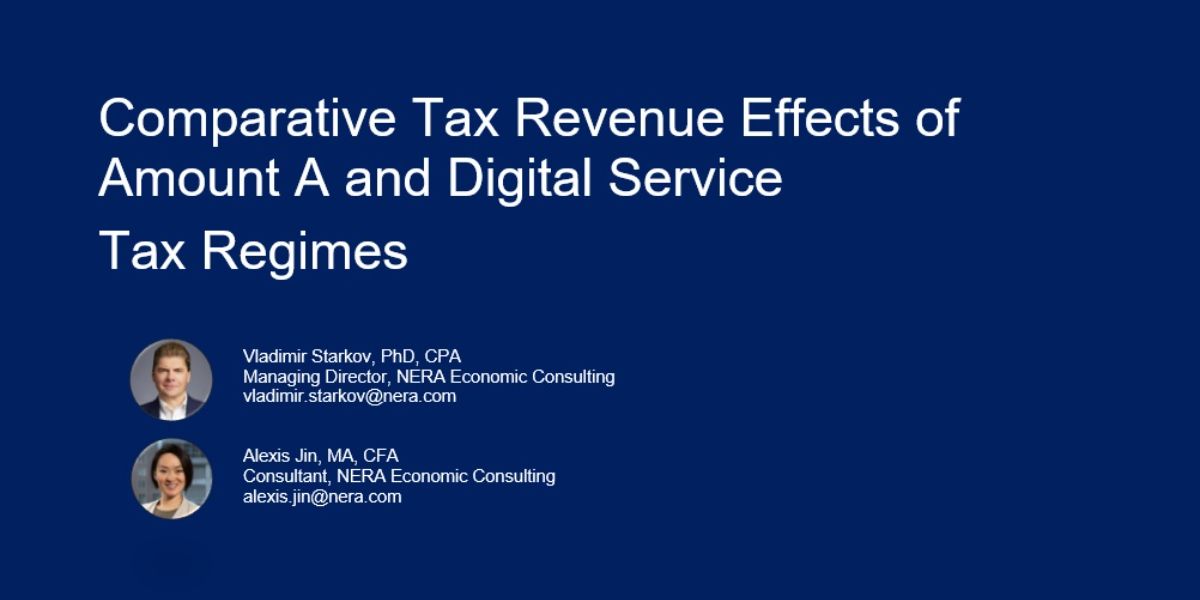As authors of several studies that estimate the tax revenue impact of Amount A for various countries and compare the Amount A impact with revenues from a model digital service tax (DST) regime, we observed certain patterns that hold true for various years and across different countries.
First, for most countries, tax revenue that could be collected from a DST that levies a 3% tax on sales sourced to the country, will be comparable to, if not exceeding, the tax revenue that the given country would receive from Amount A. The scope of the DST in our studies includes companies providing automated digital services (ADS), both the services listed in Article 12B of the U.N. Model Tax Convention and other ADS services to which DSTs could, conceivably, apply, such as software publishing, data processing and hosting, electronic commerce, telecommunications, etc.
Second, the relative tax revenue gains from Amount A and DST depend on three main factors: (i) sales sourced to the country as a market jurisdiction under Amount A, (ii) sales generated from the ADS activities in the country, and (iii) design of the rules for double tax relief by jurisdictions under the DST regime, assuming that the rules for elimination of double taxation under Amount A are fixed in the draft Multilateral Convention to Implement Amount A (MLC) released in October 2023.
The combination of the above three factors will be unique to each jurisdiction, and this unique combination is responsible for the differences in the relative size of the Amount A and DST revenues across different jurisdictions. More specifically, jurisdictions that do not host main affiliates of the multinational enterprises (MNEs) in scope of either Amount A or DST, will be expected to collect additional tax revenue from either regime (with the possible exception of investment hubs). For these jurisdictions, the choice between Amount A and DST will depend, mainly, on the specifics of the DST design (assuming that the Amount A design remains fixed).
Jurisdictions that do not meet the above description should assess the implications of both the Amount A and DST regimes for each of them specifically, because adopting each of these regimes will involve tradeoffs. For instance, countries that host parent entities or key affiliates of firms performing ADS services where these affiliates source a significant portion of their revenue abroad may have to surrender some of their tax revenues to foreign countries if a DST regime includes a double tax relief provision. Similarly, jurisdictions that host affiliates of the MNEs in scope of Amount A, including investment hubs, may find themselves surrendering a portion of their tax revenues to foreign jurisdictions as part of the relief provisions of the MLC on Amount A.
Other observations from our studies that are worth noting include the following:
- The nexus rules of the Amount A MLC spell out fairly low thresholds for establishing nexus in a jurisdiction, and MNEs in scope of Amount A may have to start paying taxes in many more jurisdictions than they used to do before. This, along with other steps that will have to be performed under the Amount A regime, will significantly increase the compliance burden on MNEs.
- The U.S. hosts parent entities of approximately half of the approximately 100 MNEs that would be in scope of Amount A. There is no other country that hosts more than ten such MNEs. This means that, should the U.S. ratify the MLC on Amount A, the workload for the U.S. tax administration will increase dramatically because the tax administration of the MNE headquarters jurisdiction is expected to become the lead tax administration for the given MNE, with various additional duties such as processing the MNE requests for various types of certainty, processing the MNE Amount A filings, collecting and distributing Amount A payments to other jurisdictions.
- Despite the fact that the scope of Amount A is fairly broad with respect to industries (effectively excluding only extractives and regulated financial services), the technology sector still accounts for approximately half of the residual profit that will be distributed to market jurisdictions under Amount A.
- In our studies, the DST revenues that are comparable in size to Amount A revenues for most countries are produced by just 200 ADS companies selected by applying a revenue threshold of 750 million euro and positive pretax income. This indicates that the DST regime does not have to be very broad in scope to raise significant tax revenues.
In view of the above observations, we believe that a multilateral convention on DSTs may be a viable alternative to the MLC on Amount A, particularly if the Amount A MLC does not move forward. An MLC on DSTs will make the application of DSTs uniform across different jurisdictions, addressing one of the main arguments that proponents of Amount A currently uphold. Further, an MLC on DSTs will provide new taxing rights to market jurisdictions, the same objective the Amount A MLC aspires to accomplish. Even more importantly, the MLC on DSTs, if scoped around digital businesses, will directly focus on the economic problem that has not been adequately resolved by Amount A, namely, taxing the value of user contributions to digital business models. It is a widely held expectation that user contributions to business models will only grow in the future as business models in many industries are becoming more digitalized. Therefore, addressing this trend by means of an MLC on DST may be the way to “future-proof” the business taxation.
Author: Vladimir Starkov is an economist and a testifying expert specializing in transfer pricing and asset valuation. He has provided consulting services for multinational companies, closely held businesses, tax authorities, attorneys, and other clients. His experience encompasses a variety of industries, including agroscience, automotive, banking, biotechnology, high technology, consumer electronics, manufacturing of consumer and industrial products, electric utilities, pharmaceuticals, petrochemicals, retail, and others.
Author: Alexis Jin is a trusted transfer pricing, valuation, and intellectual property economist and a Chartered Financial Analyst (CFA) charterholder. She advises clients on transfer pricing-related subjects including transfer pricing planning, policy redesign post-restructuring and M&A, intercompany agreements, risk assessment, compliance documentation, tax policy assessment, tax audit defense, and transfer pricing dispute resolution.

















